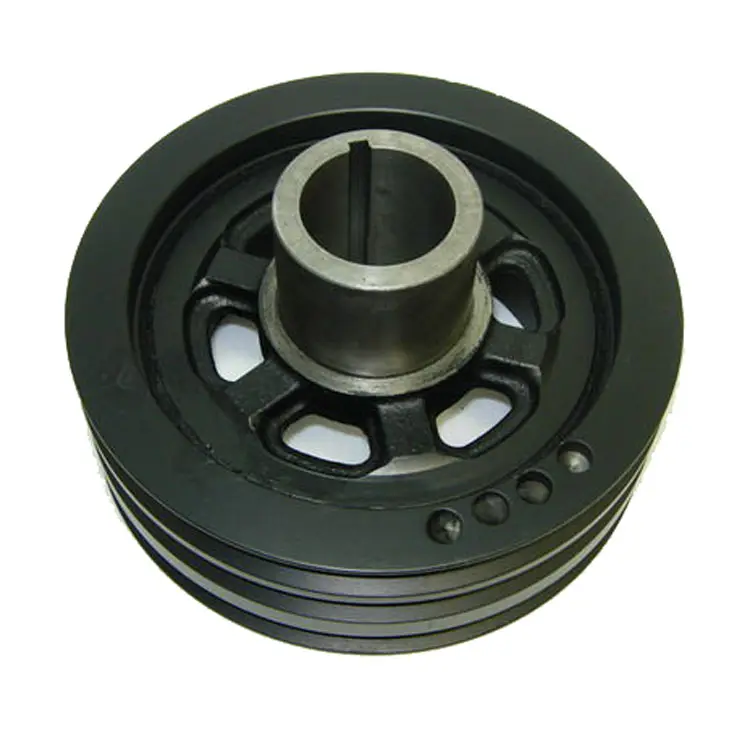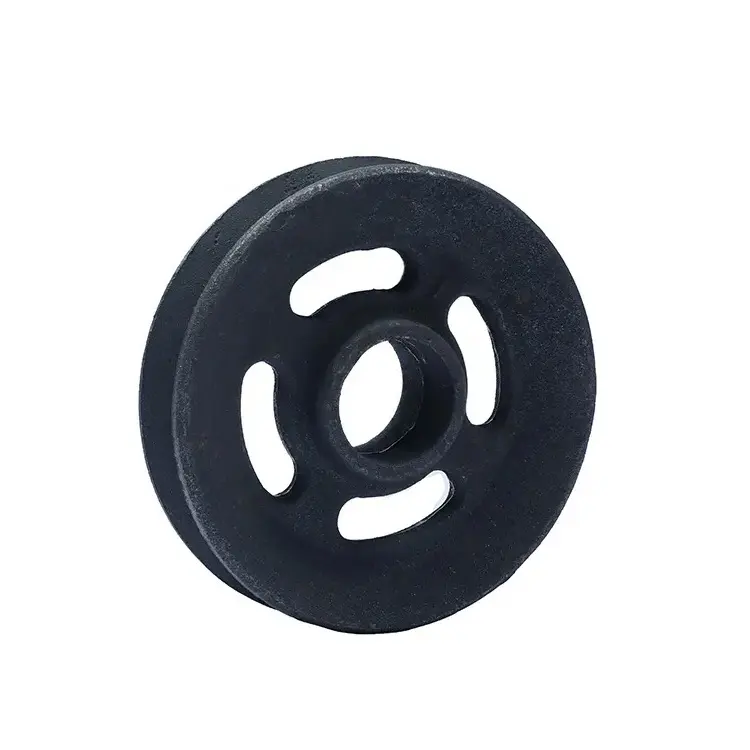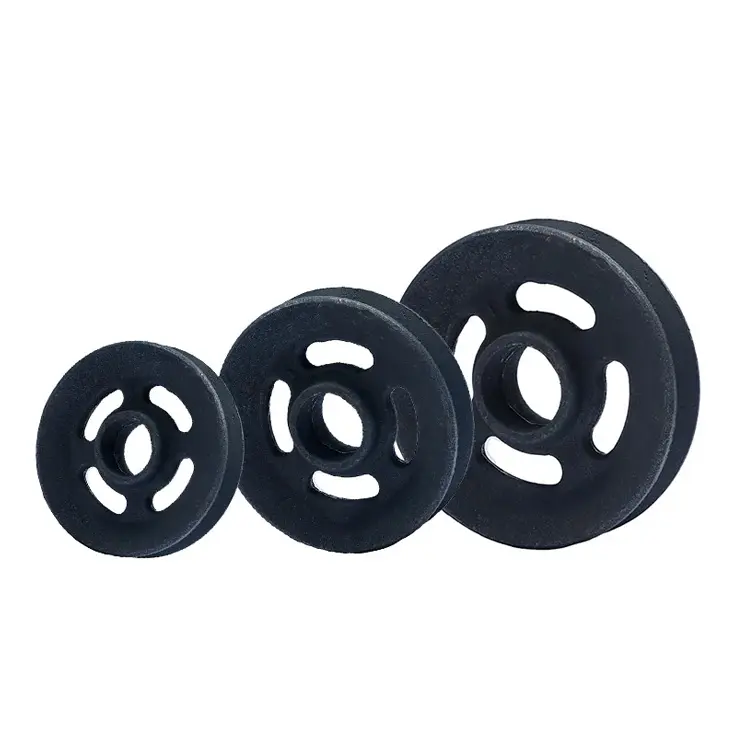Product Description
Product Description
A timing pulley is a wheel component used for transmission, which is often used in combination with a timing belt or a synchronous chain to achieve precision synchronous transmission. The timing pulley usually consists of 2 parts: the wheel flange and the hub. The wheel flange usually has a toothed structure that can be combined with a timing belt or chain to achieve a precise synchronous transmission effect. Synchronous wheels can be divided into 2 categories: grinding gear synchronous wheels and forged tooth synchronous wheels.
Product Parameters
| product | keyless timing pulley |
| material | stainless steel , iron , aluminum ,bronze ,carbon steel ,brass etc . |
| size | ISO standard ,customer requirements |
| BORE | Finished bore, Pilot Bore, Special request |
| surface treatment | Carburizing and Quenching,Tempering ,Tooth suface high quenching Hardening,Tempering |
| Processing Method | Molding, Shaving, Hobbing, Drilling, Tapping, Reaming, Manual Chamfering, Grinding etc |
| Heat Treatment | Quenching & Tempering, Carburizing & Quenching, High-frequency Hardening, Carbonitriding…… |
| Package | Wooden Case/Container and pallet, or made-to-order |
| Certificate | ISO9001 ,SGS |
| Machining Process | Gear Hobbing, Gear Milling, Gear Shaping, Gear Broaching, Gear Shaving, Gear Grinding and Gear Lapping |
| Applications | Toy, Automotive, instrument, electrical equipment, household appliances, furniture, mechanical equipment,daily living equipment, electronic sports equipment, , sanitation machinery, market/ hotel equipment supplies, etc. |
| Testing Equipment | Rockwell hardness tester 500RA, Double mesh instrument HD-200B & 3102,Gear measurement center instrument CNC3906T and other High precision detection equipments |
workshop & equipment
Production process
Certifications
Our Advantages
1 . Prioritized Quality
2 .Integrity-based Management
3 .Service Orientation
4 .150+ advanced equipment
5 .10000+ square meter factory area
6 .200+ outstanding employees
7 .90% employees have more than 10 year- working experience in our factory
8 .36 technical staff
9 .certificate ISO 9001 , SGS
10 . Customization support
11 .Excellent after-sales service
shipping
sample orders delivery time:
10-15 working days as usual
15-20 working days in busy season
large order leading time :
20-30 working days as usual
30-40 working days in busy season
FAQ
1. why should you buy products from us not from other suppliers?
We are a 32 year-experience manufacturer on making the gear, specializing in manufacturing varieties of gears, such as helical gear ,bevel gear ,spur gear and grinding gear, gear shaft, timing pulley, rack, , timing pulley and other transmission parts . There are 150+ advanced equipment ,200+ excellent employees ,and 36 technical staff . what’s more ,we have got ISO9001 and SGS certificate .
2: What are the common types of tooth profiles for synchronous belt pulleys?
A: The most common tooth profiles for synchronous belt pulleys are the trapezoidal (or T-type) and curvilinear (or HTD-type) profiles. The tooth profile determines the pitch diameter, which affects the overall ratio of the gear drive.
3 .How long is the delivery?
A: Small orders usually takes 10-15 working days,big order usually 20-35 days, depending on orders quantity and whether are standard size.
| Certification: | ISO |
|---|---|
| Pulley Sizes: | Type F |
| Manufacturing Process: | Forging |
| Material: | Stainless Steel |
| Surface Treatment: | Electroplating |
| Application: | Chemical Industry, Grain Transport, Mining Transport, Power Plant |
| Samples: |
US$ 5/Piece
1 Piece(Min.Order) | |
|---|
| Customization: |
Available
| Customized Request |
|---|

How does the design of a V pulley affect its performance?
The design of a V pulley plays a crucial role in determining its performance characteristics. Here’s an explanation of how different design aspects of a V pulley can affect its performance:
1. Groove Profile:
The groove profile of a V pulley is designed to match the shape of the V-belt used in the power transmission system. The angle and depth of the groove directly influence the grip between the pulley and the belt. An appropriate groove profile ensures a secure and efficient power transmission, minimizing belt slippage, and maximizing the transfer of torque.
2. Diameter:
The diameter of a V pulley affects both its speed ratio and torque transmission capacity. A larger pulley diameter results in higher belt speed and lower torque transmission, while a smaller diameter pulley provides lower speed and higher torque. The selection of the pulley diameter depends on the desired speed and torque requirements of the application.
3. Material:
The material used for constructing the V pulley impacts its durability, strength, and resistance to wear and corrosion. Common materials include cast iron, steel, aluminum, and plastic. The choice of material depends on factors such as the application environment, load capacity, and operating conditions. A robust and appropriate material selection ensures the pulley can withstand the demands of the application and maintain its performance over time.
4. Balance and Runout:
A well-balanced V pulley is essential to minimize vibration and ensure smooth operation. Imbalances can lead to increased wear on the pulley, belt, and bearings, reducing the overall efficiency and lifespan of the system. Similarly, excessive runout (eccentricity) in the pulley’s rotational movement can cause belt misalignment and increased friction. Proper design and manufacturing techniques are necessary to achieve optimal balance and runout in V pulleys.
5. Taper and Flange:
In some V pulley designs, a taper or flange is incorporated to improve belt tracking and prevent belt wandering or jumping off the pulley. The taper or flange helps guide the belt and maintain proper alignment, enhancing the overall performance and reliability of the power transmission system.
6. Hub Design:
The hub design of a V pulley determines its attachment method to the shaft. It can feature keyways, set screws, or other mechanisms to securely fasten the pulley in place. The hub design should ensure a tight and reliable connection to prevent pulley slippage and maintain accurate power transmission.
7. Surface Finish:
The surface finish of a V pulley can impact its friction characteristics. A smooth and properly finished surface reduces friction between the pulley and the belt, promoting efficient power transmission and minimizing heat generation. Additionally, surface treatments such as coatings or platings can improve the pulley’s resistance to corrosion and wear.
Each of these design factors contributes to the overall performance of a V pulley in terms of power transmission efficiency, belt grip, durability, and reliability. Manufacturers carefully consider these design aspects to ensure optimal performance and compatibility with specific applications and operating conditions.

What is the role of V pulleys in HVAC systems and air conditioning units?
V pulleys play a significant role in HVAC (Heating, Ventilation, and Air Conditioning) systems and air conditioning units by facilitating efficient power transmission and driving various components. Here’s a detailed explanation of the role of V pulleys in HVAC systems and air conditioning units:
1. Blower Motor Drive:
In HVAC systems and air conditioning units, V pulleys are commonly used to drive the blower motor. The blower motor is responsible for circulating air through the system, facilitating the movement of conditioned air into the desired space. The V pulley provides the necessary power transmission to drive the blower motor efficiently.
2. Fan Drive:
V pulleys are also employed in HVAC systems to drive fans that assist in airflow and heat exchange. These fans include condenser fans, evaporator fans, and circulation fans. The V pulley connects the motor to the fan, enabling the fan to operate at the desired speed to enhance heat transfer and air circulation.
3. Belt-Driven Compressors:
In some HVAC systems and air conditioning units, V pulleys are used in conjunction with belt-driven compressors. The compressor is responsible for pressurizing and circulating the refrigerant throughout the system, facilitating the cooling process. The V pulley provides power transmission from the motor to the compressor, allowing for efficient operation of the cooling system.
4. Speed Control:
V pulleys allow for speed control in HVAC systems and air conditioning units. By using pulleys of different sizes, the speed ratio between the motor and the driven components can be adjusted. This flexibility in speed control enables precise airflow regulation and cooling capacity adjustment based on the specific requirements of the space being conditioned.
5. Belt Tensioning and Alignment:
Proper tensioning and alignment of the belts are essential for efficient power transmission and to prevent belt slippage or premature wear. V pulleys in HVAC systems are often accompanied by tensioners and idler pulleys that help maintain the correct tension in the belts and ensure proper belt alignment. Proper tensioning and alignment contribute to the overall efficiency and longevity of the system.
6. Noise Reduction:
V pulleys, along with properly tensioned belts, contribute to the smooth and quiet operation of HVAC systems and air conditioning units. The design of V pulleys, combined with the flexibility and smooth engagement of V-belts, minimizes noise generation, providing a quieter environment for occupants.
7. Durability and Maintenance:
V pulleys used in HVAC systems and air conditioning units are typically made of durable materials such as steel or aluminum. These materials can withstand the demanding conditions of HVAC operation, including high temperatures and continuous use. Regular maintenance, including inspection, lubrication, and occasional belt replacement, ensures the continued efficiency and reliability of the V pulley system in HVAC applications.
Overall, V pulleys are integral components in HVAC systems and air conditioning units, enabling efficient power transmission, precise speed control, and reliable operation of blower motors, fans, compressors, and other components. Their design features, combined with properly tensioned belts, contribute to the overall performance, airflow, and cooling capacity of HVAC systems, ensuring optimal comfort and energy efficiency in various indoor environments.

How do V pulleys differ from other types of pulleys?
V pulleys, also known as V-belt pulleys or sheaves, have distinct characteristics that set them apart from other types of pulleys. Here’s an explanation of how V pulleys differ from other pulleys:
1. Groove Shape:
The most notable difference between V pulleys and other pulleys is the shape of the groove on their outer circumference. V pulleys have a V-shaped groove, which is specifically designed to accommodate V-belts with a trapezoidal cross-section. This groove shape provides a wedging action that enhances the grip between the pulley and the belt, reducing the likelihood of slippage.
2. Friction-Based Power Transmission:
V pulleys utilize a friction-based power transmission system. The V-belt wraps around the V pulley, creating a frictional contact between the belt and the groove. This friction allows for the transfer of rotational motion and torque between the driving source and the driven component. In contrast, other types of pulleys, such as flat pulleys or timing pulleys, may employ different mechanisms, such as flat belts or toothed belts, for power transmission.
3. V-Belt Compatibility:
V pulleys are specifically designed to work in conjunction with V-belts. V-belts are flexible rubber belts with a trapezoidal cross-section that match the V-shaped groove on the pulley. The shape and dimensions of the V-belt are precisely engineered to provide optimal contact and grip on the V pulley. This compatibility between the V pulley and the V-belt ensures efficient power transmission and reduces the risk of slippage.
4. Torque Transmission:
V pulleys are particularly suitable for high torque transmission. The wedging action created by the V-shaped groove and the corresponding shape of the V-belt allows for efficient power transfer even under heavy loads or during sudden changes in speed or direction. The design of V pulleys enables them to transmit higher levels of torque compared to some other types of pulleys.
5. Speed Variation:
Another distinctive feature of V pulleys is the ability to achieve speed variation in power transmission systems. By changing the diameter of the V pulley, different speed ratios can be achieved between the driving source and the driven component. This flexibility in speed control allows for proper matching of operational requirements and efficient power transmission.
6. Damping Effect:
The flexibility of V-belts and the slight elasticity of the rubber material used in V-belts provide a damping effect in V pulley systems. This helps absorb vibrations and shocks in the mechanical system, contributing to smoother operation, reduced noise, and increased component longevity.
7. Common Applications:
V pulleys are commonly used in various applications, including automotive systems, industrial machinery, HVAC systems, and power transmission systems in appliances. They are especially prevalent in systems where high torque transmission, speed variation, and reliable power transmission are required.
By understanding the distinctive features of V pulleys, engineers and designers can select the appropriate pulley type for specific applications, considering factors such as power requirements, torque transmission, speed control, and belt compatibility.


editor by CX
2023-10-07